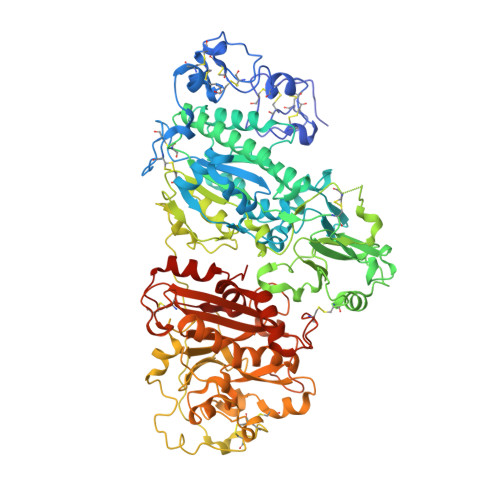Screening and X-ray Crystal Structure-based Optimization of Autotaxin (ENPP2) Inhibitors, Using a Newly Developed Fluorescence Probe
Kawaguchi, M., Okabe, T., Okudaira, S., Nishimasu, H., Ishitani, R., Kojima, H., Nureki, O., Aoki, J., Nagano, T.(2013) ACS Chem Biol 8: 1713-1721
- PubMed: 23688339
- DOI: https://doi.org/10.1021/cb400150c
- Primary Citation of Related Structures:
3WAV, 3WAW, 3WAX, 3WAY - PubMed Abstract:
Autotaxin (ATX), also known as ectonucleotide pyrophosphatase/phosphodiesterase 2 (ENPP2), was originally identified as a tumor cell autocrine motility factor and was found to be identical to plasma lysophospholipase D, which is the predominant contributor to lysophosphatidic acid (LPA) production from lysophospholipids. ATX is therefore considered to regulate the physiological and pathological roles of LPA, including angiogenesis, lymphocyte trafficking, tissue fibrosis, and cancer cell invasion and metastasis. Thus, it is a potential therapeutic target. Here, we first developed a sensitive and specific ATX fluorescence probe, TG-mTMP, and used it to screen ATX inhibitors in a large chemical library. This probe, which is superior to previously available probes FS-3 and CPF4 in terms of sensitivity or specificity, enabled us to identify several novel ATX inhibitor scaffolds. We solved the crystal structures of ATX complexes with the hit compounds at high resolution (1.75-1.95 Å) and used this information to guide optimization of the structure of a selected inhibitor. The optimized compounds, 3BoA and its derivatives, exhibited potent ATX-inhibitory activity both in vitro and in vivo. These inhibitors are expected to be useful tools to understand the roles of ATX in vitro and in vivo and may also be candidate anti-ATX therapeutic agents.
Organizational Affiliation:
Graduate School of Pharmaceutical Sciences, The University of Tokyo, 7-3-1 Hongo, Bunkyo-ku, Tokyo 113-0033, Japan.
























